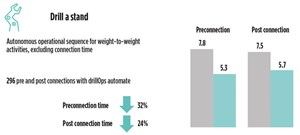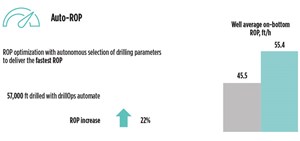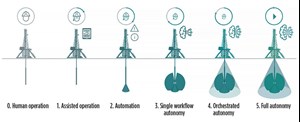Beyond automation: Driving advances in autonomous drilling
To successfully compete in increasingly difficult economic and political climates, energy companies have to dramatically improve upstream performance. Operators need to increase their focus on improving drilling efficiency, while reducing the carbon footprint involved in finding and lifting each barrel.
Automation is playing a key role in improving efficiency of E&P workflows; however, automation, alone, is not enough to achieve the necessary improvements. Today’s automation technology is helpful, but not comprehensive. To transform performance, fundamentally and continuously, the industry requires advanced autonomy capabilities.
The current and ongoing pressure on revenues and profits is driven by multiple structural changes, whether it’s decarbonization, the “energy transition,” or the generational hand-over in the global E&P workforce. The pandemic has added another layer to an already highly pressurized situation.
The net result? In many cases, a barrel of oil is priced below a field’s break-even point. To shift the profitability equation back into the black, operators and OFS companies have reduced costs, restructured, and pivoted to new strategies. However, these efficiency gains that the industry has harvested, to date, are just the low-hanging fruit. Additional capex and opex reductions are still required, as market conditions continue to deteriorate.
DIGITAL TRANSFORMATION
To survive, ever higher performance must be achieved to further lower costs. Planning and operational execution need to be improved significantly and be more consistent. The most promising method to achieve this goal is through digital technologies. Together, the industry has made great strides in creating foundations for its digital transformation over the last two years. It has incorporated the cloud into its work processes to create a shared approach to data. The industry is also fully embracing AI and is ramping up its use of automation to increase speed, while improving efficiency.
The area where some of the biggest gains are yet to be realized is well construction. This is where much of the industry’s automation efforts are focused: automatically planning and building a well, to drill faster, with greater consistency and efficiently—with less human intervention.
But drilling is also where automation, as we currently know it, has already hit its technical limits. While there is still considerable value left to be unlocked by today’s automation work, if we focus purely on automating well construction, as if we were automating a factory—in prescribed sequences of actions triggered by set parameters in a controlled environment—we will not achieve the necessary step-change in performance and efficiency that the industry requires to remain economically healthy. To make rapid gains today and evolve faster, we need to look beyond automation. We need to develop autonomy.
AUTOMATION VS AUTONOMY
There is abundant discussion in the literature about “intelligent” automation. However, just as common sense is surprisingly uncommon, it appears most of these systems are currently not intelligent at all. Effective as they are, they simply mechanize a series of repetitive actions that have been programmed explicitly to perform. Apart from the simplest applications, automated processes usually still require close human oversight and only work continuously in near-perfect conditions. Adding intelligence enables machines to perform more complex tasks, in less predictable operating conditions. That is where autonomy can help.
Drilling is the perfect application to implement these changes, with multiple decisions that have to be made quickly at the wellsite. Reducing the number of people required on site increases the workload on those that remain; a better solution is to implement autonomous systems remotely overseen by office-based human operators.
To date, there have been many valuable technical initiatives, like the systems that assist drillers in making decisions on the rig floor. However, they provide drilling guidance, rather than automation, with human intervention required to interpret data and carry out the appropriate actions.
By reducing these “handing back” instances, this allows the system to make decisions on what to do next, based not on one, but on many parameters—not on a small number of predefined scenarios, but on a wealth of experience and learnings. This process will truly transform drilling. The more decisions that can be undertaken by the system autonomously, the more value is created.
What is autonomy? Autonomy is Greek for “self-rule.” An autonomous system is defined by intelligence, complexity and decision-making ability. Based on a wide range of complex alternatives, an autonomous system can independently decide a course of action to execute a given task without depending on human oversight and control.
In a well construction context, this type of system can significantly lessen the cognitive burden and the pressure to make the correct decisions that the humans managing complex processes experience. To achieve that, we have to delegate some of the decision-making to the system itself. We have to give it, safely and wisely, degrees of autonomy. We can do, and are doing, this already.
The journey toward autonomy. By adding degrees of autonomy to tasks and processes, we can supercharge current automation efforts in well construction. The following typology shows the spectrum of automation with, and without, machine autonomy, from purely manual human operation through to a point where humans merely define goals and set objectives. Everything else is carried out autonomously by systems, Fig. 1.
Human operation. No automation. End-to-end manually performed workflows.
Assisted operation. Machine feedback enabling singular automatic adjustments, in line with user-defined constraints.
Automation. Automation of a workflow is dependent on user input. Systems provide status notifications and alarms, based on predefined thresholds.
Single workflow autonomy. Self-regulating systems that continually and autonomously prioritize and respond to simultaneous events, adapting without human intervention to deliver a single workflow.
Orchestrated autonomy. Changes are orchestrated and dynamically prioritized on multiple workflows to deliver the best outcome without human intervention.
Full autonomy. Achieves defined objectives in any scenario autonomously, managing unexpected circumstances while equaling or surpassing human performance.
While we strive for full autonomy in well construction, single-workflow autonomy and orchestration applied to sub-workflows are possible today. What these types of autonomy deliver is comparable to the human body’s autonomic system that regulates everything from our blood pressure and heart rate to our glucose levels. This analogy highlights one key difference to “automation only,” and it lies in how the system reacts if something unexpected happens.
An automated system can be thought of as following a flow chart. Explicit directions for any decision point (e.g., switch on if the temperature is <20°C) are coded in advance, and it follows these to the letter. But if there is any deviation from what it expects, it stops and waits for human help. That might be acceptable for a thermostat but not for preventing stuck drill pipe.
In contrast, systems governed by higher degrees of autonomy can handle multiple complex issues simultaneously, constantly shuffling priorities, based on their view of the world sensed through multiple incoming data streams. Crucially, they don’t have to hand back control to humans when a problem arises, but, instead, will sort it out themselves. The implications for efficiency and performance are significant.
AUTONOMOUS DRILLING
Autonomous systems are truly superior in dynamic environments, where it is not possible to exhaustively test for all conditions ahead of time—something that applies to well construction and many other oilfield activities. Progress made over the last few years in mechanizing rig equipment, adding sensors and digitizing workflows means that drilling is ready for autonomy. It can be added in small doses, where it has the biggest impact. To date, a handful of key processes have been enhanced through autonomy. Here are a few examples.
Autonomy in action #1: autonomous directional drilling. The autonomous directional drilling (ADD) system from Schlumberger has spearheaded autonomous drilling development for the past 18 years. In planning, it employs the DrillPlan* coherent well construction planning solution’s predictive steering workflow, to optimize the bottomhole assembly (BHA) and well trajectory as part of the digital drilling program.
On the rig, the digital drilling program drives the ADD system’s directional drilling advisor, which handles the analytics required for steering and executing well trajectory. It calculates any steering changes needed to reach the next target—while ensuring all future targets and total depth position are satisfied. Linked directly to the drilling advisor, the surface system executes all physical steering activity while facilitating seamless remote connectivity and control for directional drilling (DD) personnel. The ADD system’s autonomy is most evident downhole. The autonomous and self-steering BHA can not only hold and manage both inclination and azimuth, but is able to drill the most challenging 2D and 3D curves autonomously without any intervention from the surface.
Successful deployments of the autocurve downhole closed loop automation have taken place in ten wells across both the Eastern and Western hemispheres. Operators have experienced up to 20% ROP increases as a result of these deployments. In addition, the ADD digital acquisition system has been utilized on more than 750 wells in North America throughout 2020.
In one example, predictive steering enabled an operator to increase the intended dogleg severity (DLS) of curves, based on the modeled expected tendency. This gave the operator the confidence to safely drill a 10˚/100-ft DLS curve—significantly higher than previous wells drilled using conventional methods.
Autonomy in action #2: drilling a stand. Schlumberger has developed the DrillOps* on-target well delivery solution, with its automation capability ultimately as an autonomous, goal-oriented system that enables degrees of autonomy in a range of workflows and subprocesses.
Within the solution we have developed DrillOps Automate, that is capable of drilling a complete stand without the intervention of the driller. Such an autonomous system includes three components: 1) a planning agent capable of adaptively laying out the activities required to drill a full stand; 2) a component capable of optimizing the performance of the system (ROP optimizing) and constantly adjusting the drilling parameters; and 3) features that can dynamically cope with drilling dysfunctions, such as stick-and-slip or hard stringers.
The automated system constantly senses and refreshes its view of the world through sensor data and, as it knows the decisions it has already made, can take them into account in making the next decision. How much or how little control is given to the system (within clearly defined remits) is determined by the humans in charge.
The dynamic planner maps the system’s path to the next goal, as defined in the digital drilling plan, and then monitors and marshals a stable of lower-level adaptive routines that each handle individual tasks like drilling ahead, downhole tool linking, or back-reaming. Similar to the human body’s autonomic system, the adaptive routines have a range of fast and slow responses; if the travelling block touches the top of the derrick, it needs to be stopped immediately while downhole issues might need to be monitored for some time before a decision can be made. With most drilling equipment still operated manually, some, or even many, of the solution’s actions or decisions will currently be executed the same way—manually. This makes no difference to the dynamic planner. It is always aware of what is happening, with seamless hand-offs between automated sub-systems and manual actions.
It simply carries on, executing the digital drill plan, prompting the driller with the next action, if necessary. With the autonomous architecture largely already in place, these manual “gaps” will gradually be filled in, as the software and hardware required go into service.
The dynamic planner in the solution has been joined by a multi-level planner, with drill-to-depth functionality available initially and additional functionalities to be added. This expands the on-target well delivery solution’s ability to manage multiple workflows and execute the entire digital well construction plan. It will be able to control more rig systems—fluids, drilling, geosteering—simultaneously.
AutoROP is the DrillOps Automate optimized drilling mode during drill-a-stand automation. Unlike traditional drilling automation, it constantly takes a much wider view of operations.

While on bottom drilling, it still concurrently monitors and manages numerous other systems, ready to choose the next best action, based on goal, sensor data and standard operating procedures (SOPs). It doesn’t stop drilling to initiate a downlink with the directional tool, thus increasing efficiency.
Though the driller remains fully informed and can take over at any time, the solutions can now handle multiple, other drilling tasks (depending on an individual rig’s equipment), from drilling off or moving the string to the connection point to stopping rotation and pumps.
For weight-to-weight activity—the unproductive part of drilling—it cuts pre-connection time by an average 32% and post-connection time by 24%. It also can auto-initiate downlinks more quickly with a far higher success rate, and almost always without needing to pull off bottom. In testing in over 50 wells on land and offshore, with a mix of IOCs and NOCs across the Middle East, North/South America and Norway, the DrillOps solution demonstrated record shoe-to-shoe drilling performance with fewer bit runs, Fig. 2.
During friction tests, it adheres rigorously to SOPs, with test logs of the block position showing just how much variation is introduced by drillers. The same consistency was apparent in pre-connection times; DrillOps Automate achieved consistently low times that made it far more efficient overall.
Finally, due to its situational awareness and adaptive capabilities, the system can efficiently cope with drilling dysfunctions. If the bit hits a stringer or there are stick/slip issues, the solution can detect the abnormal conditions and attempt to characterize the cause, then work out the next best action to take on its own.
A simple example would be detecting excess downhole vibration and reducing WOB or RPM to protect the directional tool. Once data show the problem has been mitigated, the solution may decide to ramp up WOB/RPM again or keep settings
lower for now. If multiple dysfunctions strike simultaneously, it can manage those, too. The key benefit is that there is no need for the driller to take manual control, which saves time, and also no need for the directional driller to constantly check vibration data, to ensure the tool is not being destroyed. This means the directional driller (based remotely onshore) has less to do, and so can manage more rigs simultaneously.

DrillOps Automate also typically returns to faster ROP more quickly, based on the real-time downhole and other data that it receives, Fig. 3. For example, it may sense that the bit has entered a softer section of the formation (faster ROP, cuttings data from mud engineer), so vibration is less likely to re-occur. Humans tend to stay longer within conservative control parameters, especially if a problem occurs multiple times, which produces lower ROP, overall.
PATH FORWARD
The case for autonomy lies in the performance gains that can be realized in complex, dynamic environments and workflows, similar to those we find in well construction. This is possible now, building on technology foundations that are already being put into place.
Autonomy means automation in well construction can benefit from available intelligent technologies, taking AI capabilities close to the action, where they encode knowledge and capture learnings. Autonomous systems enable companies to reduce the number of humans required on-site to execute a job, resulting in a positive impact on overall HSE and the use of resources (through reduced travel, for example). It also enables them to deploy human expertise more efficiently, meaning experts can operate at a bigger scale, across wells and projects.
As the environment and other inputs evolve over time, autonomous tools can adapt and learn, in order to cope with today’s challenges, then feedback those learnings for application tomorrow. Autonomous systems can learn from historical information. They absorb data on previous challenges and store only the best solutions. Rather than relying on a human memory and individual interpretation, they ensure vital information is remembered and applied. This enhances human decision-making.
Just as clever, adaptive, self-regulatory processes in our bodies mean that we do not have to remind ourselves permanently to breathe or tell our heart that it can stop racing, because the danger has passed, autonomous drilling processes free human operators to focus on goal-setting and other higher-level tasks. In the future, we will work side-by-side with capable autonomous systems.
It is the natural next step to augment the adaptiveness of systems to the ever-changing conditions of well construction activities. It is enhancing automation by adding a human quality to machine activity. It is the key to capturing the performance improvements that will ensure a sustainable future of our industry.
- Coiled tubing drilling’s role in the energy transition (March 2024)
- Digital transformation/Late-life optimization: Harnessing data-driven strategies for late-life optimization (March 2024)
- The reserves replacement dilemma: Can intelligent digital technologies fill the supply gap? (March 2024)
- Digital tool kit enhances real-time decision-making to improve drilling efficiency and performance (February 2024)
- E&P outside the U.S. maintains a disciplined pace (February 2024)
- U.S. operators reduce activity as crude prices plunge (February 2024)



